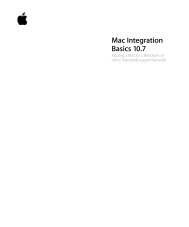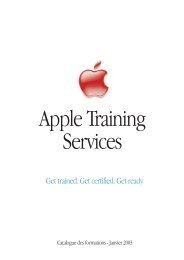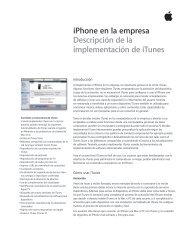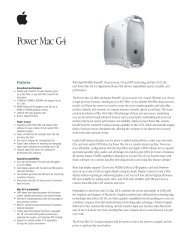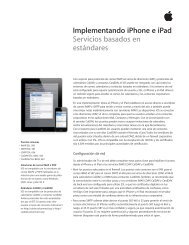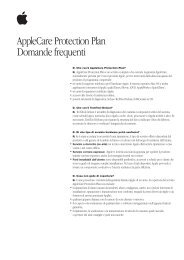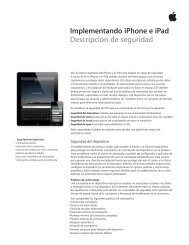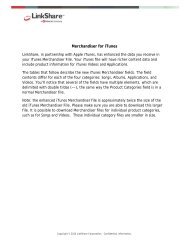In-House App Development Accelerator Guide - Apple
In-House App Development Accelerator Guide - Apple
In-House App Development Accelerator Guide - Apple
Create successful ePaper yourself
Turn your PDF publications into a flip-book with our unique Google optimized e-Paper software.
<strong>In</strong>struments. The <strong>In</strong>struments application is a powerful performance measurement tool that lets you<br />
peer into your code as it’s running and gather important metrics about what it’s doing. You can view<br />
and analyze the data <strong>In</strong>struments collects in real time, or you can save that data and analyze it later.<br />
Data recording. Tell <strong>In</strong>struments which app to analyze and which instruments to use. Click the big<br />
red button to start the recording process. Data is collected and stored for further analysis.<br />
Visual comparison. As data is recorded and displayed over time, it’s easy to see relationships between<br />
di∂ erent types of collected data as well as the same data collected over multiple runs.<br />
Drill down. <strong>In</strong>spect data spikes on the graph to see what code is executing when the spike occurs,<br />
then easily jump into Xcode to fi x the problem.<br />
Play back. Create an ad hoc test harness by recording a user interacting with your app, then play<br />
back the recording to see how code changes a∂ ect the performance.<br />
Automated UI testing. Built-in automation instrument works from scripts (written in JavaScript)<br />
that you provide to drive the simulation of events in your app. These synthetic events are generated<br />
with the help of the accessibility interfaces built into iOS. You can use this instrument to improve<br />
your testing process and exercise the user interface elements of your app while it’s running on a<br />
connected device.<br />
Looking Ahead<br />
As discussed throughout this chapter, the tools and resources provided in the iOS SDK allow you to<br />
rapidly develop breakthrough apps that take full advantage of the capabilities of both iOS and the<br />
device. Additionally, with the iOS SDK, your apps are ready for deployment at a moment’s notice. <strong>In</strong><br />
fact, many in-house development teams take an iterative approach to the entire development process,<br />
building and deploying apps frequently throughout the project life cycle. With integrated validation<br />
and testing and a security model that protects your enterprise data, you can deploy your apps to users<br />
and groups of any size. The next chapter will walk you through the app distribution process step by<br />
step and help you craft a strategy that fi ts your own unique business environment.<br />
Planning • Design • <strong>Development</strong> • Deployment<br />
<strong>In</strong>struments collects and displays data in real time, such as disk, memory, or CPU<br />
usage, making it easy to pinpoint problem areas.<br />
“ One tool that was invaluable for<br />
us was the Static Analyzer, which<br />
was able to look for problems<br />
without having to actually run<br />
the app. Something that could’ve<br />
taken us weeks or months of<br />
debugging, or things that we<br />
may have never found, the Static<br />
Analysis tool was able to fi nd it<br />
immediately.”<br />
—Mark McWilliams, Razorfi sh<br />
25





